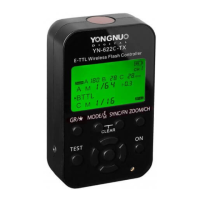The Other YN-622C User Guide v.4.09
11/12/2014
Part II – 622C Transceivers Page 57 of 64
TROUBLE SHOOTING
Aperture, distance are not displayed on the flash when half pressing the shutter
• With the flash on the transmitter, use the menus to set the flash mode or shutter sync.
Cold temperature results in failure
• Batteries can have their output reduced to below operating voltage in cold conditions. This
is less likely to arise with Alkaline cells.
Erratic Behaviour
• Un-mount all equipment, then re-mount ensuring each hot-foot is pressed fully in.
• Replace the batteries in the 622Cs, preferably with Alkaline ones. Make no assumptions.
• Reset the 622Cs to factory default settings. (Hold [CH SET] and [GP Set] until the Status
indicator flashes red/green three times, then release.)
• Reset your Speedlite. Instal the Speedlite directly on a type A camera, and reset the flash
using the menus “Flash Control / Ext Flash Function settings / Clear Speedlites Settings”
and "Flash Control / Clear External Flash C.Fn settings", which re-set most main and C.Fn
settings.
• Reset the camera to its factory default settings.
External flash function menu not available
• The transmitter is not installed correctly. Ensure that it is re-seated fully.
• The contacts of the hot shoe are dirty. Clean both sets of contacts, including under the rails
• One or both batteries are exhausted. Replace BOTH.
E-TTL underexposure or overexposure:
• Suggest enabling wireless flash function when using E-TTL flash mode, and adjust the
position of the flash, use FEC/FEL function, check flash’s effective range.
• It may overexpose when E-TTL and manual flash are used at the same time; the manual
flash suits being used as a backlight.
E-TTL Automatic Adjustments – AFR and NEVEC
Canon has two technologies which can produce exposures which are not expected. AFR is
Automatic Flash Reduction, and NEVEC (Negative Evaluative Exposure Compensation) provides
automatic ambient reduction.
• The EOS 1D professional bodies do not have these features.
• With AFR, camera modes TV, AV and M default to fill flash mode and AFR is applied:
under 10 EV: AFR is not applied, and exposure is for a flash-lit scene; 10 EV to 13 EV: AFR
is applied increasingly; Over 13 EV: AFR of 1.5 to 2.0 f/stops gives a fill-flash exposure.
• NEVEC is applied in AV or TV mode but not M. It reduces background exposure so the
foreground flash makes it “pop”. Ambient may need to be reduced to allow room for flash.
E-TTL determines the Flash output required on top of the reduced ambient.
• This chart shows the effect of the two together. It can be quite substantial!
EV AFR
(FEC)
NEVEC
(EC)
ISO400
Effective
ambient:flash
ratio
7 0 -1 1:2
8 0 -1 1:2
9 0 -1 1:2
10 -0.5 -0.5 1:1
11 -1 0 2:1
12 -1.5 0 3:1
13 -2 0 4:1

